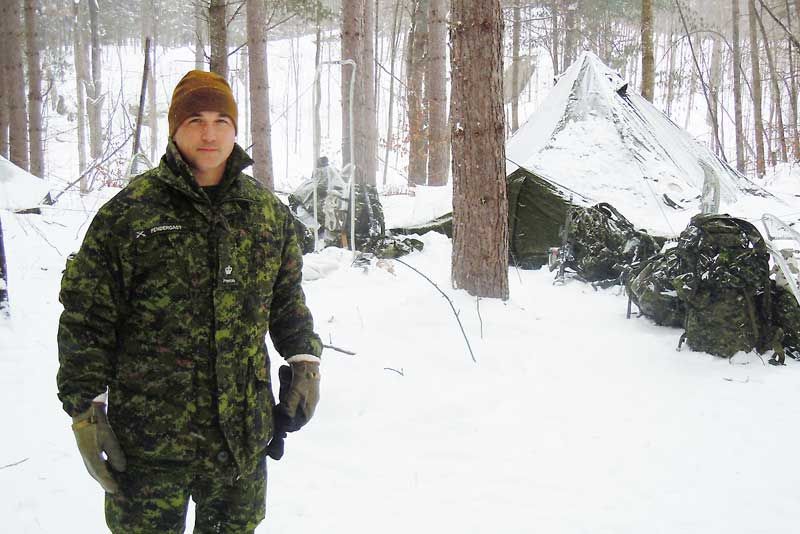Feb 11, 2015
Under the leadership of J.P. Pendergast, operations officer with the Princess of Wales' Own Regiment in Kingston, 34 soldiers and cadets spent a cold weekend camping on the property of Jen Farnum and Marcus Saunders, located near Clarendon in Central Frontenac, learning the basics of winter warfare.
The group usually camps on crown land, but when they were exploring the access points to crown land closer to Kingston so that they could spend more time training instead of traveling, they happened upon the Saunders property and were given permission to camp there, which also gave them access to over 20,000 acres of crown located just beyond it.
The group arrived on February 6 after dark, set up their camp and went to work immediately. The weekend training included formal classes and hands-on learning that teach the participants the basic skills of winter warfare. The focus is primarily on the skills for surviving in a winter environment, skills that are often unknown to people who come from urban populations.
“What we teach here would be no surprise to people who spend a lot of time trapping and hunting outdoors in the winter months but for those who have never experienced that, there is a lot to learn,” Pendergast said.
The group camped in three 10-man, bell-shaped arctic tents, each equipped with a two-burner Coleman stove and a single lantern and they ate the majority of their meals outdoors. The participants learned to build makeshift outdoor snow shelters and one participant built and slept overnight in what is known as “a winter coffin”, a 3x6 foot hand dug snow bed, which once dug is covered in branches and a waterproof tarp.
When I visited the camp I came across two senior officers chatting casually inside what Pendergast called a “quinzee”, a fully enclosed snow dome shelter that they had built. They packed down snow using their snow shoes and pierced it with sticks, then they dug it out from the inside, using the inlaid sticks to show them the depth to dig to. The structure had a hedgehog-like appearance and was 10 degrees warmer inside than the biting temperature outside.
The soldiers and cadets, who were dressed in specially made winter camouflage gear, also built numerous shelters out of fallen trees. They built lean-tos and other pit-type tree shelters in the woods surrounding one large open field. Other activities taught in the course included bear paw snow shoeing and cross country skiing. Participants also learned winter navigation techniques and how to construct various snow defenses, which consisted of trenches built of snow and ice. In a war time situation these would protect them from enemy fire.
The group came with their C7A2 service rifles. They did not fire them but they were shown how to properly carry them while skiing and snow shoeing and how to service them in the winter climate. The group endured ample snow fall and well below average temperatures that often dipped below -20 degrees Celsius and felt even colder with the wind chill. Pendergast said that to avoid hypothermia and frost bite, participants took regular breaks out of the wind.
It was the group's first time at the Saunders farm and Pendergast said that the property served perfectly for their purposes. “We had ample privacy and access to all of the different kinds of terrain necessary for our training. We saved ourselves a lot of traveling time, which made our time here more productive than if we had traveled further north.” He added that he would come back in a heart beat. “The Saunders were great hosts and we had an opportunity to show the Saunders' kids some of the things we were doing, which they really seemed to get a kick out of.”
Winter survival in the great outdoors is serious business and whether in times of peace or war, many of the teachings in this course would come in handy to soldiers and civilians alike. Perhaps Pendergast and some of his crew might welcome an invitation to next year's Frontenac Heritage Festival, where they could teach festival goers how to build their very own quinzee or winter coffin.
More Stories
- No Winner Yet in Catch The Ace But Fundraising Target Met
- South Frontenac Food Bank Opens Second Location in Battersea
- Sharbot Lake Pentecostal Church Anniversary - 1925-2025
- Frontenac Holistic Health Fair - September 20 At Storrington Centre
- Odd Year For Real Estate - But Sales Are Steady Year Over Year
- 193rd Kingston Fall Fair
- Kim Phuc - the Napalm Girl - To Visit Flinton In November
- South Frontenac Council - September 2
- Sticker Shock - EV Charging Station To Cost North Frontenac Township
- 30th Anniversary Verona Car Show

